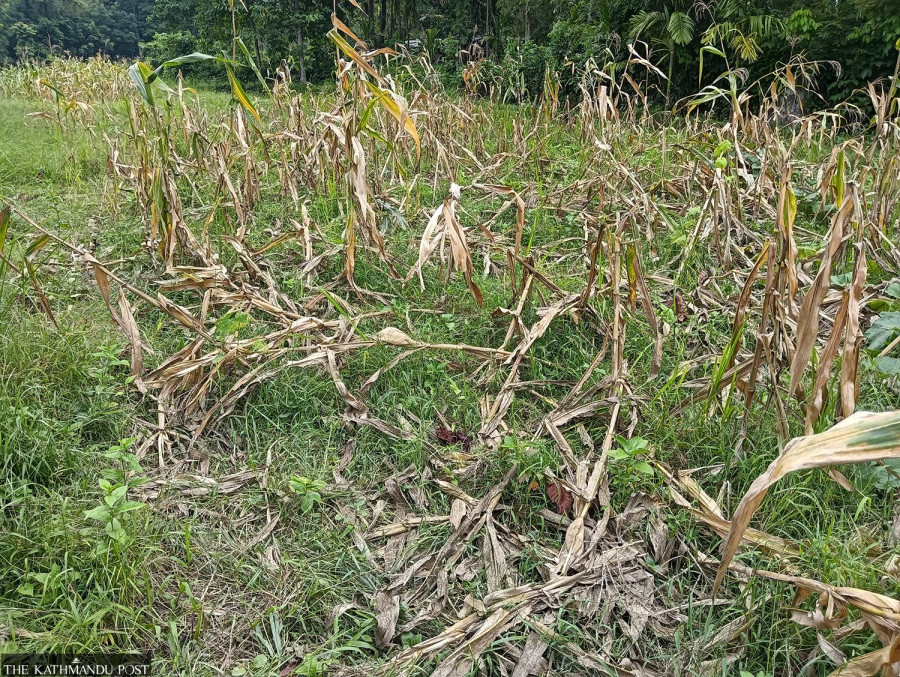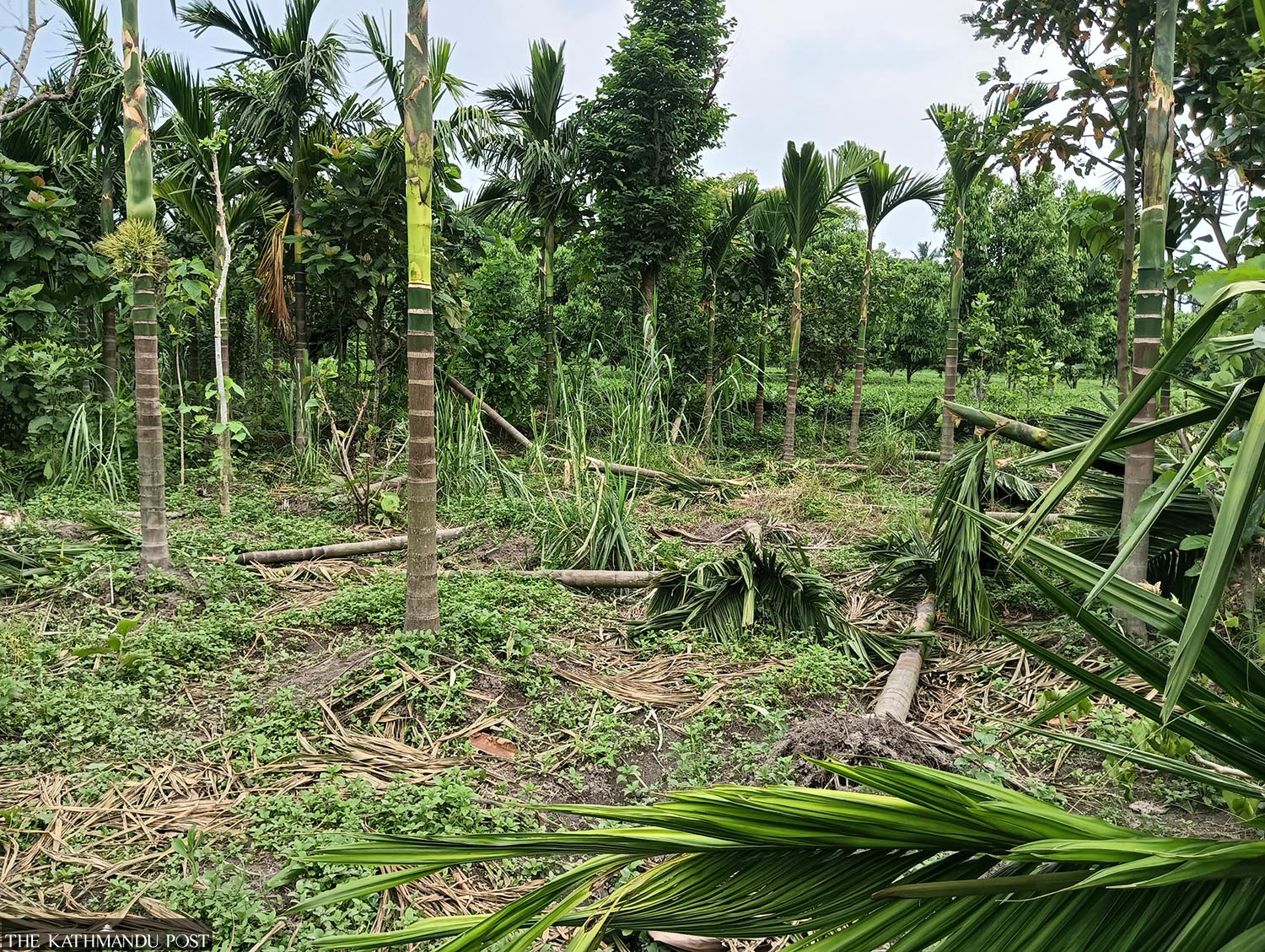Koshi Province
Elephant raids are now routine in Jhapa’s Bahundangi
What were once rare visits by one or two elephants have turned into regular invasions by huge herds of 50 to 60, complain residents.
Nawaraj Subedi
It was 2 am on June 10. A herd of approximately 20 wild elephants sneaked into Shantitole of Bahundangi in Jhapa district. While most residents were fast asleep and unaware of the intrusion by dawn, half a dozen families discovered their maize fields were destroyed by the marauding elephants.
Sita Sunar, aged 38, is one of the affected farmers. She had cultivated maize on about 10 kattha (0.33 hectares) of land she rented on a sharecropping basis. “We had purchased improved seeds at Rs400 per kilo and the maize had grown really well this season,” she recalled while fertilising her betel nut plants. “But just as the corn was ready for harvest, the elephants arrived and ate everything. Even the grass trampled by the herd is no longer suitable for livestock fodder.”
The loss went far beyond her own fields. The elephants also ravaged the crops of her neighbours planted in a few bigha of land.
Sita is aware that government relief is available for losses caused by wildlife, but there is a catch. Applying for compensation requires land ownership documents and citizenship papers. Although she possesses her citizenship card, she lacks land ownership documents as the property owner lives in India. “Since the land isn’t mine and the landlord is absent, I have no way to produce the ownership certificate. Besides, the process to claim compensation takes over six months. That’s why I didn’t even apply,” she said.
For Sita, the elephants didn't just consume a single season’s crop—they wiped out a year’s worth of hard labour, the family's food supply, and their primary source of livelihood. This is a recurring problem for Bahundangi, a small settlement in ward 4 of Mechinagar Municipality. Wild elephants are no longer an occasional nuisance. What once used to be sporadic visits by one or two elephants have now turned into regular invasions by huge herds numbering 50 to 60.
Human-elephant conflict has plagued the area for decades, but in recent years, the scale and frequency of elephant raids have increased. “Earlier, we used to see one or two elephants. Now they arrive in large numbers, often with calves,” locals say.
The invading herd of jumbos devoured approximately 1,600 kg of maize in Shantinagartol alone, leaving behind destroyed stalks and flattened fields. Locals tried desperately to chase the animals away, but with little success. After several hours of destruction, the herd finally left but not before causing severe damage.
On June 13, another herd of around 45 elephants crossed the Mechi river into the Bahundangi area. Despite the deployment of Nepal Police and Armed Police Force at the riverbanks attempting to steer the elephants back towards India, their efforts proved futile.

That night, the elephants entered the betel nut plantation belonging to Yuvaraj Pokharel, where around 600 trees had been planted on one bigha (0.67 hectares) of land. The herd snapped more than 400 trees, most of which were flowering and would never recover.
“The wild elephants entered around 1:15 am and stayed in the plantation until nearly 3 am,” said Dibyaraj Pokharel, Yubaraj's brother, pointing to the broken trees. “The locals blocked their path with human chains and sirens, but with nowhere else to go, the elephants remained here for hours, causing extensive damage,” he lamented.
The destruction caused by these herds is not limited to crops alone. Sometimes they destroy houses and other property, making Bahundangi a perpetual battle zone between humans and elephants.
Over the years, locals have experimented with multiple deterrence strategies. Many started beekeeping, believing that the buzzing of bees might repel the elephants. Others tied ropes coated with chili powder around their fields. Hundreds of trees believed to discourage elephant entry, locally called "Hatti bar” were planted along field borders. Some even dug trenches. But none of these methods have provided a sustainable solution.
“The only measure that worked effectively was solar-powered electric fencing along the border,” said Nilkantha Tiwari, a local. “When the fence was fully operational, we saw up to a 98 percent reduction in elephant intrusions. Cross-border herds stopped entering and only a few local elephants would cause trouble,” he added.
However, the solar fencing system has fallen into disrepair. Many of the structures are damaged or missing and maintenance has been neglected. “If the solar fence were properly maintained, much of this destruction could be prevented,” said Tiwari, urging authorities at municipal, provincial, and federal levels to take urgent action. “The municipality is discussing the issue, but we need serious commitment from all levels of government.”
For many in Bahundangi, sleepless nights have become the norm. Every evening brings the same anxiety: Will the elephants come tonight? Whose fields will they raid?
The municipality acknowledges the problem. “We’ve held several rounds of discussions within the municipality and with security agencies and the District Administration Office. There’s consensus that repairing the solar fence is a priority,” said Agni Prasad Adhikari, chief administrative officer of Mechinagar Municipality. According to him, if higher authorities do not allocate sufficient funds, the municipality is preparing to set aside some budget for urgent repairs.
The Division Forest Office in Jhapa is also aware of the escalating crisis. Office chief Bharat Babu Shrestha confirms that Rs956,000 has been allocated for solar fence maintenance in the current fiscal year of 2024-25.
“The problem isn’t just the elephants and the fence. In many cases, the fences have been deliberately cut to create illegal routes for transporting riverbed materials. Even local people damage the fences, worsening the situation. Nevertheless, we still believe that solar fencing is the most effective solution and repair work is underway,” said Shrestha.




 16.12°C Kathmandu
16.12°C Kathmandu















